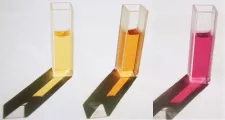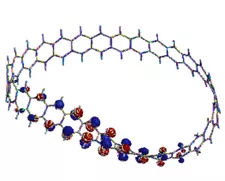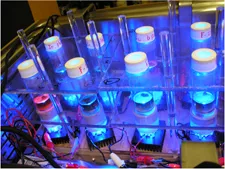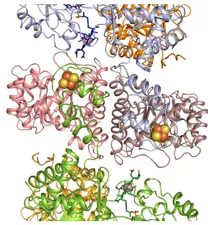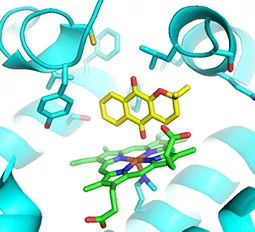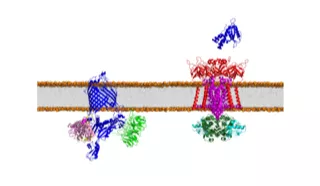Research Areas of the Graduate Faculty
Sharon J. Nieter Burgmayer
W. Alton Jones Professor of Chemistry
Inorganic and Bioinorganic Chemistry
Ph.D. University of North Carolina, Chapel Hill
Research in the Burgmayer labs involves two areas of bioinorganic chemistry. One project is focused on modeling the catalytic site of the molybdenum enzymes. These enzymes are widely distributed throughout Nature where they perform redox reactions critical to the health of organisms spanning bacteria to humans. The catalyltic unit—the molybdenum cofactor—has several redox active parts: the dithiolene, the pterin and the molydenum. The goal of this project is to understand how these three redox units affect catalytic function. A second project involves the study of ruthenium complexes that bind and can damage DNA. These projects involve both inorganic and organic syntheses, many of which are performed under inert atmosphere environments. Chemical reactivity is studied by spectroscopic analysis, such as FT-NMR, FT-IR, UV-vis, and fluorescence, and electrochemical characterization within the Bryn Mawr chemistry department. Certain projects require other techniques, such as structure determination by x-ray crystallography, EPR or MCD, that are accomplished through collaborations with researchers at other institutions.
Michelle M. Francl
Professor of Chemistry
Computational and Theoretical Physical Chemistry
Ph. D. University of California, Irvine
Professor Francl is engaged in both developing new methods for studying chemical systems using computational approaches, as well as in the application of theoretical models to problems of interest in organic, inorganic and biological systems. One example is the [n]mobiusenes, condensed aromatic molecules which mimic Moebius strips. Larger molecules are less strained than their smaller counterparts, but all show a counterintuitive localization of the twist. One imagines that the molecule would be less strained if the twist were distributed evenly around the molecule. What is the impetus for the localization? What are the consequences for the molecular reactivity? The answers to these questions can be found by mixing computational chemistry with a dash of topology and a generous dollop of differential geometry. Professor Francl's research group is taking an interdisciplinary approach to this and related problems.
Jonas I. Goldsmith
Associate Professor of Chemistry
Physical Chemistry
Ph.D. Cornell University
The research program in the Goldsmith labs combines the techniques of inorganic, physical and synthetic chemistry to develop and investigate novel transition metal complex-based nanostructures. Electrochemical and spectroscopic techniques are used to probe the interactions of transition metal complexes with surfaces and to develop applications including nanoelectronics and solar energy conversion. Bifunctional ligands are synthesized where the aromatic portion of each ligand has π-stacking interactions with carbon surfaces. Electrochemical techniques including cyclic voltammetry and the use of an electrochemical quartz crystal microbalance (EQCM) are used to study the thermodynamics, kinetics and dynamics of the adsorption process. Investigations of cobalt, rhodium adn iridium complexes are directed towards fabrication of electron relays for solar energy-based hydrogen production.
Yan Kung
Assistant Professor of Chemistry
Biological Chemistry
Ph.D. Massachusetts Institute of Technology
The Kung lab employs a variety of biochemical techniques in combination with X-ray crystallography to understand the link between enzyme structure and function. A primary research theme is to study enzymes involved in the biosynthesis of molecules with medical or industrial importance, focusing on enzymes from biological pathways which build molecules that can be used as advanced biofuel or drug targets. After first gaining a deep molecular understanding of how these enzymes work, we will then use this insight toward the rational design and engineering of proteins with more desirable functions not found in nature.
Bill Malachowski
Professor and Chair of Chemistry
Organic Chemistry
Ph.D. University of Michigan
Our research interests stretch across the field of organic chemistry from traditional areas, such as synthetic reaction development and natural product synthesis to bioorganic chemistry, including enzyme inhibitor design, synthesis and testing. In all these fields, our primary laboratory activities involve organic synthesis or constructing molecules. There are currently two active projects in the group: indoleamine 2,3-dioxygenase (IDO) inhibitor design and synthesis and natural product synthesis with the sequential Birch reduction-allylation and Cope rearrangement. The ultimate goal of both projects is to develop new therapeutics for the treatment of a variety of ailments, most notably cancer and infectious diseases.
Patrick R. Melvin
Assistant Professor of Chemistry
Organic Chemistry
Ph.D. Yale University
Research in the Melvin laboratory will focus on organic methodology and organometallic chemistry. The first project will center on the development of ancillary ligands for use in transition metal catalysis (see figure, left), while the second will pursue methodology for the synthesis of organofluorine compounds (see figure, right). Organometallic chemistry continues to revolutionize the way organic chemists approach synthetic challenges, yet limitations remain. To this end, the development of improved catalytic systems is vital. By designing novel carbodicarbenes (CDC) ligands and combining them with a nickel center, our goal will be to push the boundaries of metal-catalyzed methodologies and open up new pathways to challenging bond formations. Ultimately, these Ni complexes will be applied to pharmaceutically-relevant reactions in order to generate more efficient ways to synthesize vitally important compounds. Meanwhile, the fluorination project will expose students to the rigors of reagent and method development. Fluorine remains an incredibly versatile element that can drastically alter many biologically-relevant properties of molecules. However, installing fluorine into organic compounds is particularly challenging. We plan to address this problem through the development of improved reagents for deoxyfluorination (the exchange of an oxygen atom for fluorine). Given the prevalence of fluorine in medical research, potential collaborations in this area will show the direct benefits a student’s contribution can have in other areas of science.
Ashlee M. Plummer
Assistant Professor of Chemistry
Biological Chemistry
Ph.D. Johns Hopkins University
The Plummer lab concentrates on the functional, computational, and structural characterization of bacterial membrane proteins which play a role in the widespread virulence of bacteria. Cell membranes are amazingly complex mixtures of phospholipids and membrane proteins – these membranes surround cells and create a protective barrier against outside threats. The proteins that reside within membranes work in many critically important processes and the dysfunction of these proteins is linked to innumerable diseases, including atherosclerosis, cancer, and neurodegenerative disorders. Our work combines several different experimental techniques, including in vitro biochemical assays, structural biology-based studies, cell-based assays, and computational simulations to understand 1) how these proteins work and 2) how they interact with the surrounding lipid bilayer.
